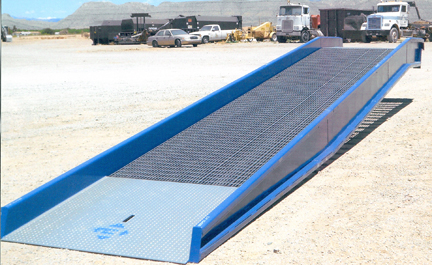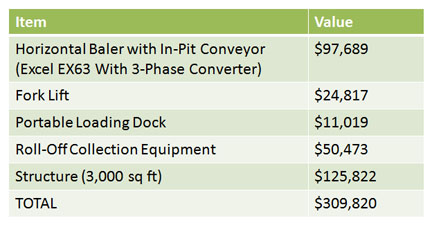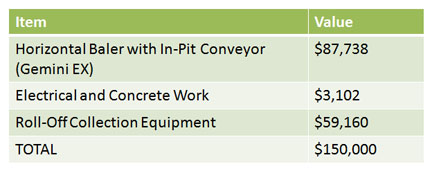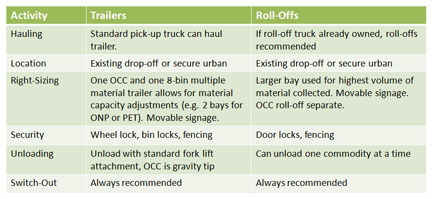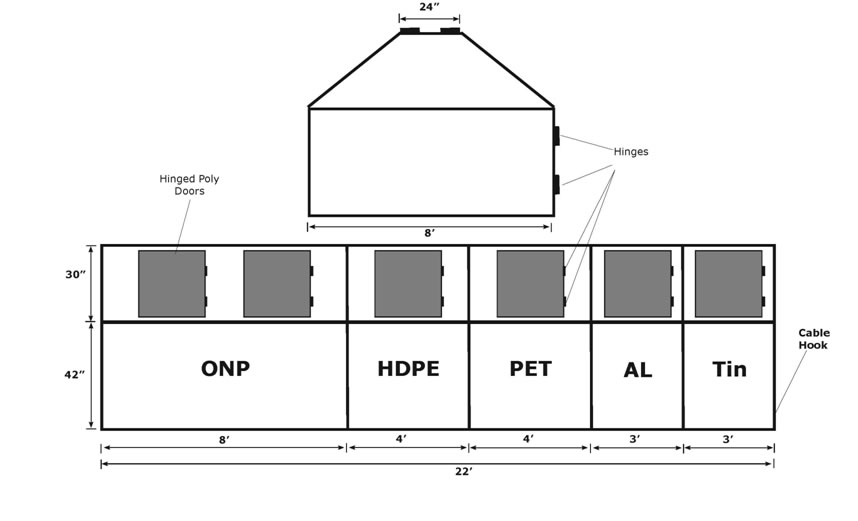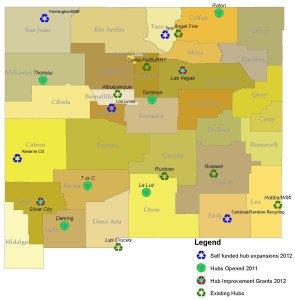
What is Hub & Spoke Recycling?
Successful recycling programs depend on efficient collection and basic processing of materials. This is achieved through the hub and spoke model, which works by creating regional recycling processing centers within larger communities that serve as “hubs” and encourages smaller communities or “spokes” to deliver their recyclables to these hubs. Recycling hubs will invest in or solicit grants for capital equipment and infrastructure needed to create and store high density bales of materials that remanufacturing markets require. Spoke communities will invest in or solicit grants for recycling collection trailers or containers. These mobile drop-off stations are easily transported to nearby recycling hubs. The hub and spoke system has been targeted as it provides the most efficient means of gathering and processing recyclables, from both a capital and operational cost perspective. Hub and spoke systems greatly reduce transportation requirements and increase overall efficiency of program operations.
In a nutshell, hub and spoke provides:
- Access to recycling
- Replicable design
- Overcomes rural transport issues
- Consolidates marketable volumes
- The hub is able to generate revenue to cover cost of operation
- Spokes are collection points that reduce tip fee costs and potentially hauling
In September 2010, NMRC began work on a $2.8 million grant from the Department of Energy to develop rural recycling infrastructure throughout New Mexico. More than two-thirds of those monies were sub-awarded to eligible rural and underserved communities to develop and expand hub and spoke collection infrastructure. NMRC aims to share all the resources, templates, designs and specifications developed under this project so that other communities, regions and states can use the materials to develop their own recycling "hubs and spokes".
.....................................................................................
Want Assistance for Your NM Community?
Contact Sarah Pierpont, sarah@recyclenewmexico.com or call 505-603-0558.
Hub and Spoke Mapping
While most urban areas of the state are well served by municipally or privately-operated processing facilities, the rural nature of the state leaves the majority of NM with little or no access to these services. This shortcoming has been clearly identified by NMRC’s Mapping Project, conducted under a U.S.D.A. Rural Utilities grant, where all solid waste facilities have been documented and mapped. This mapping effort illuminates under-served areas and demonstrates the “holes” in NM’s recycling processing capacity and the areas underserved with processing capacity. Figure 1, developed in 2009, clearly identifies the need for expanded hub and spoke recycling within NM, as there are numerous locations within the state that do not have recycling processing facilities or the existing facility is at capacity and cannot accept more materials. Hubs were selected based upon how trash flowed, assessment of existing processing, 60-100 mile range and political and geographical boundaries.
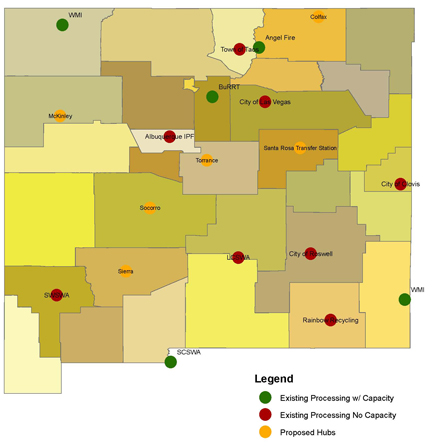
Figure 1. NM's Hub Map Based on 2009 Information
The hub and spoke model provides a simple and efficient solution to recycling collection and processing in rural communities. The hub and spoke approach has been proven in several regions of North America. The best documented case comes from the Canadian Province of Ontario, where provincial government mandated the approach to resolve the inefficiencies created when each community attempted to provide their own independent processing capacity. In rural areas of Montana, Idaho and Wyoming a cooperative effort was formed on this model and has provided a stable recycling system for a broad rural area in these states. The State of Massachusetts took the hub and spoke principle a step further by building a central hub itself and contracting its operations to a private vendor. The Springfield Municipal Recycling Facility serves a dozen or more communities with processing services and has proven to be the cornerstone of recycling efforts in Massachusetts.
If each community is left to manage recycling independently economies of scale cannot be obtained and energy will, in fact, be wasted as these scattered efforts will not enjoy the efficiencies of centralized processing. Hub and spoke is not only an effective means of handling materials, it is by far the least resource intensive.
Hub and Spoke in NM Today
Due to numerous grants programs and several years of technical assistance to develop and expand hub communities, the hub and spoke map above has vastly changed! There are only two regions that currently do not offer the full range of traditional household recycling. And almost all of the hubs that did not have capacity have expanded in order to serve their region.
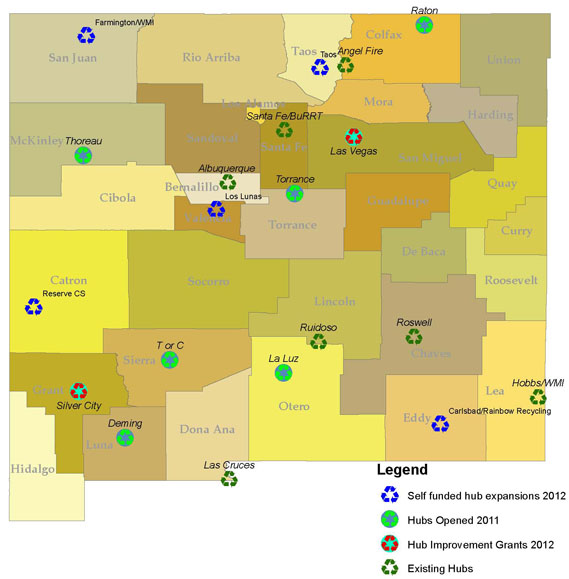
Figure 2. NM Hub Map as of September 2012
Hub Design, Equipment and Budgets
NMRC designed a recycling hub template suitable for a smaller community to economically host a regional processing facility. The infrastructure was aimed at simplicity and a relatively small initial investment. The location for a new regional hub is recommended to take place at an existing solid waste facility where existing staff can be utilized. New hubs start slow with the processing demands and build over time as more material arrives. Having cross-trained staff onsite allows for staffing flexibility.
Hub Design Template
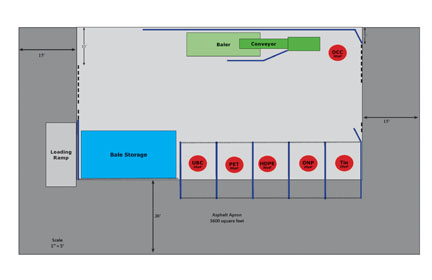
The hub is a simple, three-sided 3,000 square foot (40' x 75') building designed with clear skylights to avoid any lighting needs, 2 man-doors and 2 roll-doors. The open-side of the building is designed to be high enough to tip roll-off trucks into the bunker storage system. Each bunker can hold one bale worth of material. So when it's full, it's time to bale. Cardboard should be directly tipped into the baler and processed immediately.
The three-sided building was located so that the open side faced away from prevailing winds. There is no heating or cooling included in these buildings, running water nor offices or storage rooms. It is a simple structure made for processing recycling and that's it. The asphalt apron is important in order to control dust and to allow tipping of materials before pushing them into storage bunkers.
Lessons Learned: Planning for additional storage of both loose and baled materials is important - consider designing a larger building. If you must compile a full load of one commodity before marketing, plan for storage either in the building or in an empty semi-trailer nearby.

